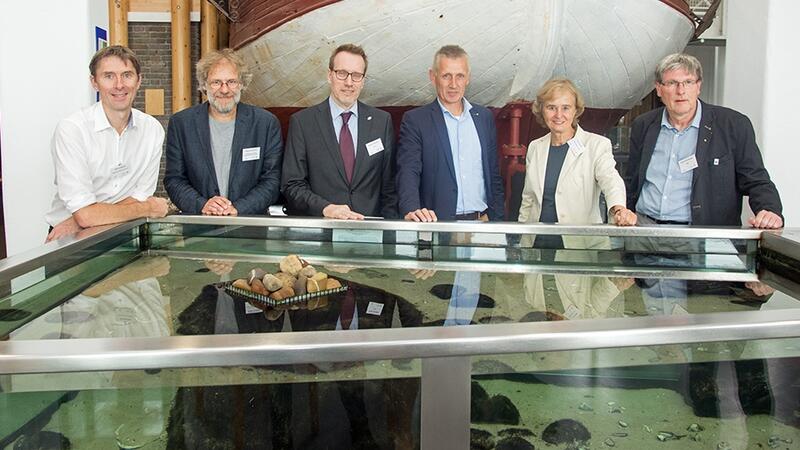Natural forces and human impact: International experts discuss sediment dynamics in the Wadden Sea

The only constant of the Wadden Sea is continuous transformation: ebb and flood, wind and waves reform the mudflats, beaches, dunes and salt marshes on a daily basis. These strong natural dynamics constitute to one of the criteria, for which the Wadden Sea has been inscribed on UNESCO’s World Heritage List, and set the scene for this year’s Wadden Sea Day. Stakeholders from the trilateral Wadden Sea community – representatives from nature conservation, research, politics and NGOs – met on 30 August 2018 at the Wadden Sea World Heritage Visitor Center in Wilhelmshaven.
“When natural sediment dynamics directly affect human settlements and activities, humankind reacts by intervening into geological and ecological processes. Examples are coastal risk management, maintenance of shipping lanes and harbours and dumping of dredged sediments,” says Peter Südbeck, Head of the National Park Administration of the Lower Saxon Wadden Sea. “With this symposium we set a focus on this area of conflict between natural sediment dynamics and human use.” Together with Rüdiger Strempel, Executive Secretary of the Common Wadden Sea Secretariat (CWSS), Uwe Reese, Mayor of the City of Wilhelmshaven, and Thomas Borchers of the German Federal Ministry of the Environment, Nature Conservation and Nuclear Safety Südbeck welcomed the 100 participants.
Introducing the topic of natural processes, Hans-Ulrich Rösner (WWF Germany) discussed the question of how much sediment management as a form of human intervention the ecosystem of the Wadden Sea is able to bear. Rösner concludes that „ Dredging and dumping cause too much damage to the protected areas of the Wadden Sea World Heritage. To become more sustainable, permissions need to be more restrictive and ships need to adapt to the environment, not the other way around.“ Jesper Bartholdy (University of Copenhagen) explored the correlation between sediment dynamics and sea level rise in the Wadden Sea.
The second half of the symposium focused on sediment management. Georg Nehls (BioConsult) gave an overview on dredging and dumping of sediments in the Wadden Sea. Robert Zijlstra and Gerard Janssen (both Rijkswaterstaat) and Martin Baptist (Wageningen Marine Research) presented insights in the status of research on sand nourishments and ecological effects on the Wadden Sea’s coastal zone. Matthäus Wuczkowski (Niedersachsen Ports) followed with an introduction on environmental friendly technologies for water depth preservation by ports. Christian Lorenzen (Municipality of Fanø) closed the presentations of the day with a Danish local perspective on sediment management.
Karsten Reise moderated (Alfred Wegener Institute) a podium discussion between representatives from fishery, coastal protection, ports, water and shipping authority, nature NGOs and nature agencies. Reise: “We need a more innovative approach if we want to protect the Wadden Sea World Heritage from the impacts of future interventions in sediment dynamics.”
Following the symposium a reception was held to honour the 40th anniversary of the Trilateral Wadden Sea Cooperation. “Since 1978 Denmark, Germany and the Netherlands have been working together to protect and conserve the Wadden Sea,” says Professor Karin Lochte, Chair of the Wadden Sea Board from May 2018. „This is a remarkable accomplishment, which documents the strong will of the three Wadden Sea states to conserve this unique landscape, driven by the personal commitment of numerous actors from politics, civil society and research. The Wadden Sea community has poured its heart and soul into this.” Next year the Wadden Sea World Heritage will celebrate its 10th anniversary. The designation of this site by UNESCO is an outstanding success of the Trilateral Wadden Sea Cooperation.
The Wadden Sea Day has been organised annually since 2006 with current topics by the National Park Administration Lower Saxon Wadden Sea and the Common Wadden Sea Secretariat.
